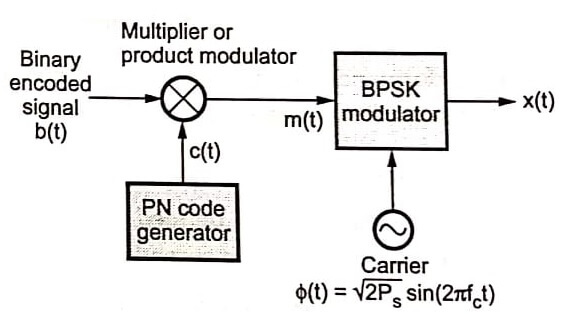In the previous subsection we studied the baseband transmission of direct sequence spread spectrum modulated signal. For long distance transmission or transmission over a satellite channel, BPSK can be used.
DS-SS BPSK Transmitter
Fig. shows the transmitter of Direct Sequence Spread Spectrum with BPSK.

The multiplier multiplies the two signals b(t) and c(t). The output of multiplier is direct sequence spread signal m(t). This signal is given as modulating signal to BPSK transmitter.
The direct sequence BPSK (or DS/BPSK) signal is generated at the output (x(t)). Let’s say that the carrier is represented as, Φ(t) = √2Ps sin(2πƒct)
Then the transmitted signal is x(t) = √2Ps m(t) sin(2πƒct)
Thus when m(t) is positive, there is phase shift of ‘0’ and if it is negative, there is phase shift of 180°.
DS-SS BPSK Receiver
Fig shows the block diagram of DS/BPSK receiver. There are two stages of demodulation. The received signal y(t) is applied to the multiplier which is also supplied with locally generated coherent carrier. The output of the multiplier is then applied the low pass filter (integrator).
The bandwidth of this low pass filter is equal to that of m(t). This stage is BPSK detector. The signal obtained at this stage is m(t).
This signal is applied to the second demodulator which despreads the signal. The local pseudo-noise signal is exact replica of that used in the transmitter.
The integrator integrates the product of detected message signal and pseudo-noise signal over one bit period ‘Tb‘. The decision is then taken depending upon the polarity of output (v) of the integrator. Output is ‘1’ if v > 0 and output is ‘0’ if v < 0.

Signal Space Dimensionality and Processing Gain
The performance of direct sequence spread spectrum system discussed in last to subsections can be evaluated on the basis of processing gain and probability of error.
Processing Gain
Processing Gain (PG) is defined as the ratio of the bandwidth of spread message signal to the bandwidth of unspreaded data signal.
Processing Gain ![]()
For the NRZ bipolar signals the band width of the signal is equal to 1/One bit period.
The waveforms of data signal spreading signal and spreaded signal m(t) are given in Fig. For the data signal (which is unspreaded) we can write,
BW (data signal) = 1/One bit period = 1/Tb.
The spreading pseudo-noise signal c(t) is multiplied by data signal and the spreaded message signal m(t) is produced. This waveform of m(t) is shown in Fig (c) Observe that any one bit period in message signal m(t) is same as that in spreading pseudo-noise signal c(t). This period is represented by ‘Tc‘ in Fig (b). Therefore we can write,
BW (Spreaded message signal) = 1/One bit period = 1/ Tc
Putting the values of the bandwidth obtained above in equation. We obtain processing gain as
Processing Gain ![]()
![]()
The Processing Gain represents the ‘Gain’ achieved by processing the spread spectrum signal over an unspreaded signal. From Fig we know that one bit period ‘Tb‘ of data signal is equal to ‘N’ bits periods of spreading pseudo-noise signal.
That is, Tb = NTc
Putting this value of Tb in equation above we get,
Processing Gain = N (some times)
Probability of Error of DS/BPSK System
We know the expression for the probability of error of coherent BPSK system. It is given as,
![]()
Here N0/0 is noise spectral density and Eb is the bit energy.
For direct sequence spread spectrum modulation the noise spectral density is given as, ![]()
or N0 = JTc
Here is the average interference power.
Therefore equation becomes,
![]()
| Read More Topics |
| Generation of pseudo noise sequence |
| Adaptive delta modulation |
| Spread spectrum techniques |





